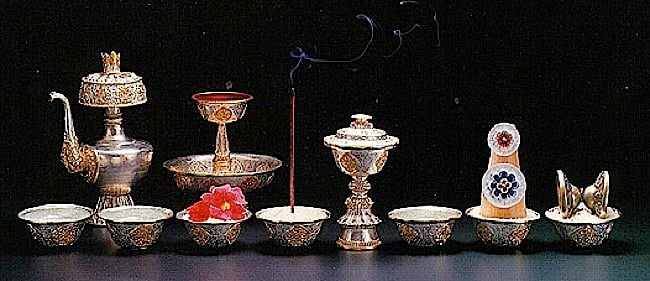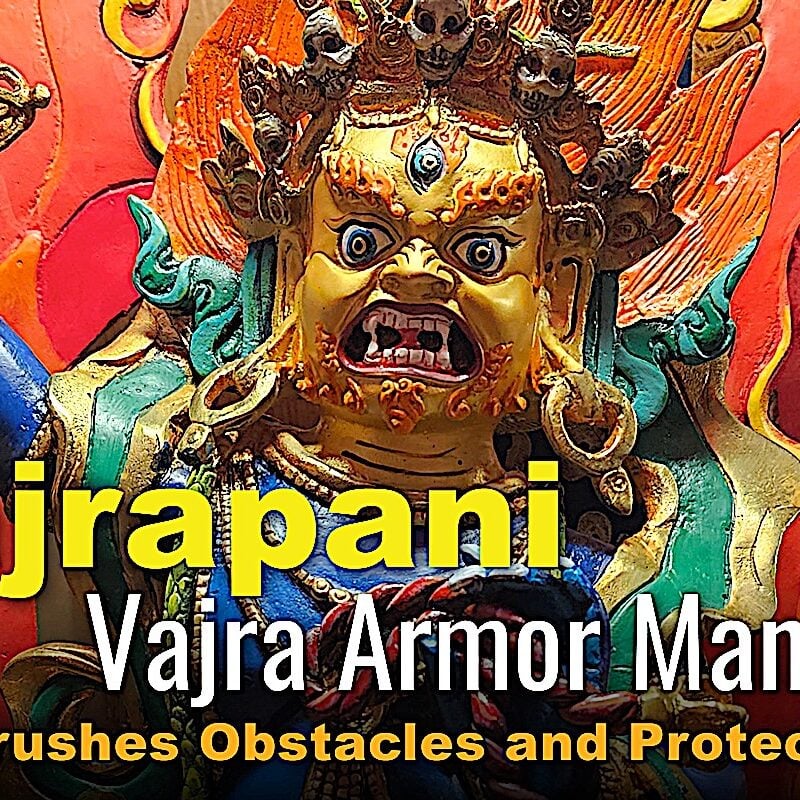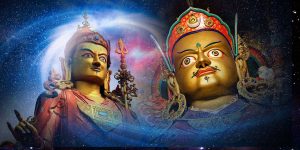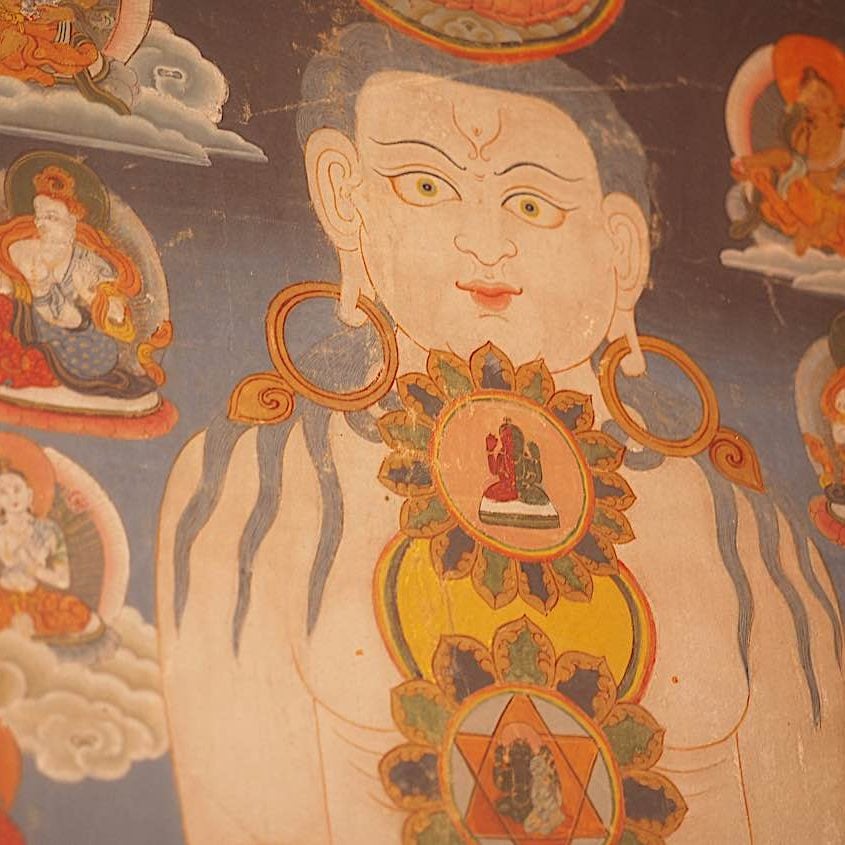Buddhist Water Bowl Offerings as an Antidote to Attachment
Basic foundation practices in Vajrayana Buddhism (and many other forms of Mahayana) include making offerings and prostrations to the Three Jewels — Buddha, Dharma and Sangha, and, in some practices, Gurus, Yidams and Dakinis. Yongchap practice, offering seven water bowls, is one of the most basic daily practices. Eight bowls is often offered as well.
“The significance of offering seven water bowls is to create the cause to achieve the seven limbs, or aspects, or qualities of the Vajradhara state — enlightenment. But that does not mean that you cannot offer more, that offering more is some kind of interference!” — His Holiness Serkong Tsenshab Rinpoche [1]
Offerings in general, are an antidote to greed and attachment, and can include charity, donations, and shrine offerings. Charity and selfless actions, a dedication to the welfare of others, help us release selfish attachment and is a bodhichitta practice. Offering to the Buddhas and Gurus first — usually in the morning before we eat — demonstrates our selfless dedication to our Bodhisattva vows and our teachers and deities.

Anything can be offered, provided it is pleasing to the five senses, including form, sounds, smells, tastes and touch. Incense is smell. Sounds might be a mantra or praise. Tastes might include fruits. For most practitioners, the basic daily offering is seven bowls of water, representing the seven practices which are highlighted in the seven-limb prayer:
With my body, speech, and mind, humbly I prostrate.
I make offerings both set out and imagined.
I declare every unwholesome action I have ever committed. I rejoice in the virtues of all beings.
Please stay until samsara ends,
And please turn the Wheel of Dharma for us.
I dedicate all these virtues to the great Enlightenment.
Offerings are not Sacrifices
In some religious practices the words offering and sacrifice are synonymous. In Buddhism an offering is for the benefit of the practitioner and all beings, not for the benefit of the Buddha or Enlightened Being. Buddhas and enlightened beings do not require sacrifices. Offerings should be obtainable without any difficulty. In fact, it is important that what we offer does not take away from others. If one wishes to offer precious gems, gold, money we don’t have, or even just fine foods — but we have to borrow, steal, or lie to obtain them — this runs counter to the principles of Buddhist offerings.
For this reason, water, the most plentiful substance in most areas, is the chosen offering. It is pure, clean, plentiful — not requiring us to hurt others to give it — and it is symbolic of purity.
The best offering is to offer our practice — to offer just ourselves and our prayers, thoughts and meritorious actions. In addition, many of us offer up beautiful flowers, incense, even the sun and the moon through visualized offerings.

Water Offerings
Although some offerings include the seven symbolic offerings of water for drinking, water for bathing, flowers, incense, light, perfume, and food. Generally, from left to right, we visualize the water bowls as the sensory offerings. These are the offerings which are the traditionally given to honoured visitors in many Asian countries:
- Water for drinking (Argham)
- Water for washing (Padyam)
- Flowers (Pushpe)
- Incense (Dhupe)
- Light: candlelight, butterlamps or fire (Aloke)
- Perfume (Ghande)
- Food (Naividya)
- Sound and Music (Shabda): in eight bowl offerings, the eighth bowl represents sound. In seven bowl practice, it is said there is not eighth bowl for sound because sound is non-visual.

Water for Purity
Other practices emphasize just seven bowls of water, representing the absolute purity of the Buddhas. Buddhas and enlightened deities obviously do not need the offerings, whether food, incense or water. The act of offering is for our own benefit, to show we think of our Bodhisattva vows first, that we wish to overcome attachments to these very things we offer. Water, without which there can be no life, is symbolic of our attachments and greed.
Seven water bowls is the most basic, yet complete offering. Some practices place a butter lamp or candle between the third and fourth water bowls. Lamps and candles symbolize wisdom and the illumination of the Dharma that releases us from ignorance. For ceremonial purposes, or elaborate offerings, the bowls might actually be filled with an offering symbolic of the sensory object, for example:
- Water (for water)
- Water with saffron (for water for washing)
- Actual blossoms or flowers (flowers)
- A stick of incense (incense), usually in a bowl of rice
- An actual butter lamp or candle (for light)
- Perfumed water or a bottle of perfumes (perfume)
- Fruit or food (food)
- A bell placed in the eighth bowl (sound) if an eighth bowl is used.
Basic Water Offering in the Morning
1. Seven clean bowls of any pleasing material, usually copper, brass or silver, but many use porcelain or glass.
2. Fill a jug with clean water, usually mentally purifying the water as it is poured, often chanting the seed syllables of Buddhas body, speech and mind: OM AH HUM.
3. Do not place an empty bowl on the shrine. Clear a space lower than the objects of veneration, which might include statues of Buddhas and Bodhisattvas (body of Buddha), Sutras (Speech of Buddha) or Stupas (Mind of Buddha). Fill the bowls one by one before placing on the altar.
4. Place from left to right, with only the space of one grain between each bowl. Continue chanting OM AH HUM or other purifying mantras and mentally visualize the water being purified or transformed into its essential nature of emptiness. Typically, mantras such as Om Mani Padme Hum, Om Muni Muni Maha Munaye Svaha or Om Tare Tuttare Ture Svaha would be chanted.
5. Make a dedication when all the bowls are filled.
Milarepa and the Empty Pot — Why Water Bowls Should Not be Empty
“Before putting the bowls on the altar you should put some water in them. There is a reason for this. You may have read Milarepa’s life-story. When Milarepa made an offering to Marpa of, I think, a big copper pot, he offered it empty. It is said that he had to live on only nettles and bear great hardships in regard to food and the necessities of life because of the dependent arising due to that inauspicious offering. Marpa, knowing that it was a little inauspicious used a skillful method and asked Mila to fill the pot with butter and wax and make a light offering. That auspicious offering was the cause for Milarepa to be able to realize shunyata and generate the clear light and illusory body in that life.” — Lama Zopa Rinpoche
More Elaborate Visualization and Mantras
For a more elaborate offering, a practitioner would follow the guidance of his teacher, or the visualization indicated in the Sadhana or ceremony. Or, for a more elaborate general offering you can include the mantras of dedication and visualization. As you empty and refill the bowls chant OM AH HUM, as above, but then dedicate each bowl, left to right, with special mantras, at the same time visualizing the water bowl as the sensory offering:
- OM ARGHAM AH HUM (Visualize many water bowls filling the skies around the Buddhas and Bodhisattvas)
- OM PADYAM AH HUM (Visualize many water bowls filling the skies around the Buddhas and Bodhisattvas)
- OM PUSHPE AH HUM (Visualize some variation of flowers filling the skies around the Buddhas and Bodhisattvas)
- OM DHUPE AH HUM (Visualize and try to sense the smell of clouds of incense filling the skies around the Buddhas and Bodhisattvas)
- OM ALOKE AH HUM (Visualize endless beautiful butter lamps filling the skies around the Buddhas and Bodhisattvas)
- OM GHANDE AH HUM (Visualize perfume bottles or water bowls with perfumed water filling the skies around the Buddhas and Bodhisattvas)
- OM NAIVIDYA AH HUM (Visualize endless foods, suitable to the deities—typically vegetarian—filling the skies around the Buddhas and Bodhisattvas)
- OM SHABDA AH HUM (Try to hear or imagine beautiful celestial music, singing bowls, bowls, drums).
Dedication
The dedication is actually very important. A mechanically place offering, without virtuous intention or a dedication — even if the offerings were priceless jewels — would have no benefit. We try to genuinely dedicate the merit of the offerings to the elimination of suffering and its causes for all beings and to their cause for enlightenment.
This would typically be the all-important Seven Limbed Prayer, which takes many forms, but typically something like the seven lines (symbolic of the seven bowls):
With my body, speech, and mind, humbly I prostrate.
I make offerings both set out and imagined.
I declare every unwholesome action I have ever committed.
I rejoice in the virtues of all beings.
Please stay until samsara ends,
And please turn the Wheel of Dharma for us.
I dedicate all these virtues to the eradication of suffering and to the great Enlightenment.
End of the Day Removal of Bowls
Most practicers empty and dry the bowls at the end of the day, some do it the next morning when the new offerings are made. To remove the bowls:
1. Remove one-by-one from right to left
2. Dry each bowl and place face down on the shrine or put them away. The water is empty and can be disposed of, but some people share the offerings with houseplants or the earth.
NOTES
11 thoughts on “Buddhist Water Bowl Offerings as an Antidote to Attachment”
Leave a Comment
More articles by this author

Guru Rinpoche is ready to answer and grant wishes: “Repeat this prayer continuously” for the granting of wishes

VIDEO: Vajrapani Vajra Armor Mantra: Supreme Protection of Dorje Godrab Vajrakavaca from Padmasambhava
Search
Latest Features
Please support the "Spread the Dharma" mission as one of our heroic Dharma Supporting Members, or with a one-time donation.
Please Help Support the “Spread the Dharma” Mission!

Be a part of the noble mission as a supporting member or a patron, or a volunteer contributor of content.
The power of Dharma to help sentient beings, in part, lies in ensuring access to Buddha’s precious Dharma — the mission of Buddha Weekly. We can’t do it without you!
A non-profit association since 2007, Buddha Weekly published many feature articles, videos, and, podcasts. Please consider supporting the mission to preserve and “Spread the Dharma." Your support as either a patron or a supporting member helps defray the high costs of producing quality Dharma content. Thank you! Learn more here, or become one of our super karma heroes on Patreon.
Lee Kane
Author | Buddha Weekly
Lee Kane is the editor of Buddha Weekly, since 2007. His main focuses as a writer are mindfulness techniques, meditation, Dharma and Sutra commentaries, Buddhist practices, international perspectives and traditions, Vajrayana, Mahayana, Zen. He also covers various events.
Lee also contributes as a writer to various other online magazines and blogs.

















This is a beautiful thing of which I was unaware till now. Thank you so much for showing it to me.
Very interesting and very lovely.
This daily practice truly is the best way to start a day. It is humbling and enlightening to make offerings to the great enlightened ones.
What books should I refer to study more on water offering? Can I have a list please
Thank you for asking. It’s a powerful practice. I try to do nine sets of eight water bowl offerings each day as a foundational practice. It’s very peaceful, a very powerful form of meditation, and it’s meritorious.
Details on water offerings would depend on your tradition, although the water bowl offering described in our feature follows Tibetan tradition. There are other offering traditions, as well. There’s a small paper back book (almost a booklet, as it’s only 40 pages long), by Lama Zopa Rinpoche. Here’s the link on Amazon>> There’s also a feature on the LamaYeshe.com website with a good discussion on the practice from Lama Zopa Rinpoche>>
There’s a great discussion on this on the site of His Holinesss the Gyalwa Karmapa here>>
For more advanced studies, it’s a foundational practice, so any good Lamrim book would cover this important practice. Lamrim practices are the step-by-step practices based on sutra and Buddha’s teachings, covering all the foundations of practice. Of course water bowl offerings is a small topic in the context of any Lamrim book. For example “Steps on the Path to Enlightenment” by Geshe Lhundur Sopa>>
There’s a terrific video and instructional on the Tibetan Culture site Yowangdu.com>
Pingback: The Purpose of the Eight Auspicious Offering Bowls - Ren Ting Online
Pingback: Happy Dakini Day! An Introduction to the Wisdom of the Female Enlightened Dakinis in Buddhism. - Buddha Weekly: Buddhist Practices, Mindfulness, Meditation
Pingback: You never out-grow Ngondro: foundation practices remain important even for advanced students, especially, meditation on precious human birth, death, karma and impermanence - Buddha Weekly: Buddhist Practices, Mindfulness, Meditation
Thanks for your sharing and it inspires me how to encourage others to practice Buddhism.
Good practice Water bowl and Butter Lamp manurels I m trying to do it but not enough place for me to do it all but I’m just doing for the name of Buddha
It’s a wonderful meritorious practice. If you don’t have room for seven bowls, just put out one, and fill and refill it seven times while visualizing making the sense offerings. It is best to pour the water out on the ground, rather than flushing down the drain as a symbol of respect. Om Muni Muni Mahamuni Shakyamuni Ye Soha.